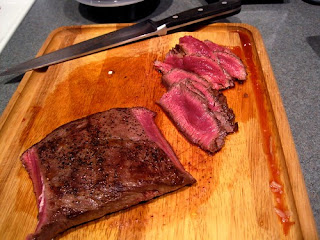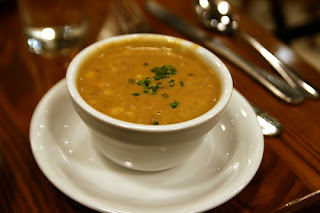from
Behind the French Menu
by
Bryan G. Newman
behindthefrenchmenu@gmail.com
All the French you
need to order a perfectly cooked steak.
Steak and French
fries (chips).
www.flickr.com/photos/dongkwan/2943140653/
The short version
for ordering a steak in
France.
Very,
very rare – Bleu
(Pronounced ble).
Rare - Saignant
(Pronounced say-nyon,
do not pronounce the T).
Medium Rare
with the accent on the rare - À Point
(Pronounced ah
pwa).
À Point
Medium-rare.with the accent on the rare.
www.flickr.com/photos/bokchoi-snowpea/4454588117/
Medium rare, closer to
medium - Entre à Point et
Bien Cuit.
(Pronounced awntr
a pwan ay bien kwee).
Medium to
well done -
Bien Cuit
(Pronounced bien
kwee).
Well
done - Très
Bien Cuit
(Pronounced tray
bien kwee).
N.B. An exceptionally well-done steak;
however, “très bien cuit” is not in any French chef’s dictionary though
it will be clearly understood. Be careful when ordering!, Do not order France's popular steak frites
very well-done; you will be served cooked cardboard or leather, that is if the server agrees to take
your order.
For an in-depth answer
on ordering steak in France click on this post:
More detail in this post.
To begin with there
is no direct translation
for medium or medium-rare.
Read on.
Read on.
North American and UK steakhouse terms
such as medium, medium-rare, or well-done do NOT translate, conceptually, into
traditional restaurant French. Your English-French travel dictionary may offer
the word Moyen as the translation of the word medium, and that is correct.
Unfortunately, in French Moyen is not used as a cooking term.
Ordering a steak requires little French.
It does not matter whether you order a steak in English, or in perfect or
poorly accented French. Every French
waiter understands an order for a steak. Problems only appear when the
waiter asks: Quelle cuisson, votre steak? How would you like
your steak cooked?
Check these pictures.
A lexicon of French
terms for ordering a steak or cuts of beef
Bleu – Bleu is also the French word for the
color blue, and for a steak, it means very, very rare; leaking onto the plate when
cut. When you feel the need for an
almost raw steak, then a steak bleu will fill that need. A steak bleu indicates
that the chef will have allowed the steak to take a quick peek at the grill or
frying pan, in passing, on its way to your plate. A steak bleu is just sealed
on the outside; when cut that steak will leak copiously onto your plate; it
will have been cooked, maybe, for one to two minutes on each side. (Bleu
is pronounced ble).
Saignant – French for a rare steak. The direct translation into
English of the word saignant would be bloody, or bleeding; despite that, a
steak saignant will have been cooked a little more than a steak bleu. A steak
saignant will also leak, when you cut into it, though less copiously than a
steak bleu. In North America and the UK, a steak saignant will
still be considered a rare steak. (Pronounced say-nyon, do not pronounce the T).
Saignant
A rare steak.
www.flickr.com/photos/bhamsandwich/5520541126/
À point - Perfectly cooked,
just ready or just right. À point is the term used, in France, for all
perfectly cooked foods, and not for steaks alone. Unfortunately, many
guidebooks give the term à point as the way to order a medium-rare steak. A
perfectly cooked steak, for most French men and women, is NOT medium-rare; rather, it is a rare-to-medium-rare, a lot closer to rare than the US or UK
medium. (Pronounced ah pwa).
À point
Medium-rare.with the accent on the rare.
I prefer my steaks cooked à point, (medium-rare with the
accent on the rare), but that is my choice. French servers with experience with
English-speaking tourists will agree, generally with a smile, to take your à
point steak back into the kitchen for a few more minutes on the grill, or the
frying pan when à point is too rare for your tastes.
When English speaking
diners, in France, wish to order their steaks medium-rare, I suggest they order
steaks cooked entre à point et bien cuit. That translates as “between well cooked and à
point” the result will be a US or UK medium-rare steak, closer to medium than
rare. For a medium-rare steak just ask for your steak entre à point et bien
cuit. See the following paragraph.
Entre à Point et Bien Cuit – In France, entre à point et bien
cuit has worked well for me when ordering a steak cooked to medium for friends. All French servers will understand it. A
French diner sitting near you, and observing you order a steak cooked entre
à point et bien cuit may consider your steak as overcooked; however, you
are paying the piper. (Pronounced awntr a pwan ay bien kwee).
Entre à Point et Bien Cuit - Medium
www.flickr.com/photos/140547216@N04/42441238032/
Moyen – Average or
the middle. In the French kitchen, the word moyen has nothing to do with steaks. Look
to the two previous paragraphs and the terms À point or Entre à
Point et Bien Cuit to order a medium-rare or medium steak.
Bien Cuit – Bien cuit translates into English as well done; however,
an order for a steak bien cuit, in France, generally produces a
medium-to-well-done steak. A steak bien cuit will not run at all;
however, its center will still be slightly rosé, pink. (Pronounced bien kwee).
Bien Cuit
Very slightly rose
in the center.
www.flickr.com/photos/suburbanadventure/6855666864/
Très Bien Cuit – Very well cooked; an extremely well-done
steak. Unfortunately, très bien cuit is not used for steaks in French
kitchens; I made it up. Despite that, all servers with some experience
with overseas visitors will understand the request. For the French très bien
cuit means a very overcooked steak, and the server may ask you to repeat
that instruction. If you have ordered steak
frites, an experienced server may advise you re-consider, or order
something else. The cuts used for France’s relatively inexpensive steak
frites are usually flank steaks or hanger steaks, and a well-done flank or hanger steak will be tough and tasteless, practically inedible. For an enjoyable meal
with a well-done steak, I suggest that you look through the menu again.
Consider ordering a more expensive entrecôte, or change your request for your
steak très bien cuit to just bien cuit. (Pronounced tray bien kwee for very, very well-done).
The French view of a steak cooked très bien cuit, very well done.
------------------------------------------
Behind the French Menu
by
Bryan G. Newman
behindthefrenchmenu@gmail.com
Copyright 2010, 2012, 2013, 2018, 2019.
-----------------------
Searching for the meaning of words, names or phrases
on
French menus?
Just add the word, words, or phrase that
you are searching for to the words "Behind the French Menu" (best
when including the inverted commas), and search with Google, Bing, or
DuckDuckGO. Behind the French Menu’s links, include hundreds
of words, names, and phrases that are seen on French menus. There are over 450
articles that include over 4,000 French dishes with English translations and
explanations.
Steaks and cuts of beef on French menus:
When ordering your steak remember the French
Steak de Hampe - A Flavorful French Cut of Beef With no
Corresponding USA or UK Cut to Compare With.
Photograph by MonkeyBusiness/YayMicro.com




















